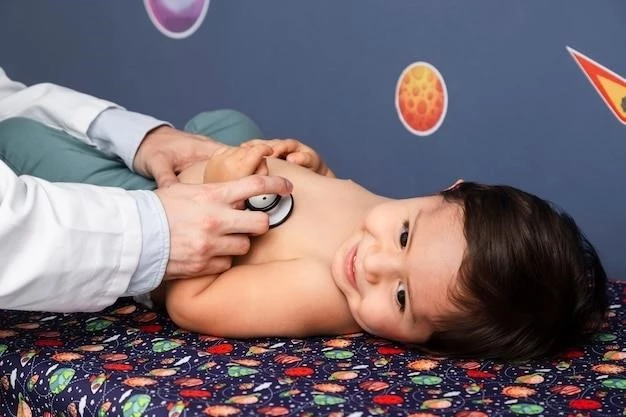Craniofacial Deformities in Children⁚
When facing craniofacial abnormalities in children, early diagnosis and proper management are crucial. Make sure to consult with pediatric specialists for the best treatment options tailored to your child’s specific condition.
Craniofacial Abnormalities⁚ Diagnosis and Management
Diagnosing craniofacial abnormalities early on is crucial for effective management. Consult with pediatric specialists who can perform thorough evaluations, which may include imaging tests and genetic analysis. Treatment approaches may vary depending on the specific condition, ranging from orthodontic interventions to corrective surgeries.
It’s important to work closely with a multidisciplinary team consisting of pediatricians, surgeons, dentists, speech therapists, and psychologists. This collaborative approach ensures comprehensive care tailored to your child’s needs.

Throughout the diagnostic and treatment process, remember to communicate openly with healthcare providers, ask questions, and seek support from family and support groups. Understanding your child’s condition and treatment plan can help you make informed decisions and provide the best possible care.
Additionally, consider exploring educational resources and programs that cater to children with craniofacial abnormalities. Early intervention and ongoing support can positively impact your child’s development and overall well-being.
Support Services for Individuals with Craniofacial Conditions
Individuals with craniofacial conditions may benefit from a range of support services to enhance their quality of life and well-being. Here are some valuable support services to consider⁚
- Support Groups⁚ Joining support groups connects individuals and families facing similar challenges, providing emotional support and a sense of community.
- Counseling Services⁚ Counseling can help individuals cope with the social and emotional aspects of living with a craniofacial condition.
- Educational Resources⁚ Accessing educational materials and workshops can empower individuals and families with knowledge about the condition and available resources.
- Speech and Language Therapy⁚ Speech therapy can enhance communication skills and address any speech difficulties related to craniofacial abnormalities.
- Dental Care Services⁚ Dental professionals experienced in treating craniofacial conditions can provide specialized care to maintain oral health.
Additionally, government programs, nonprofit organizations, and charitable foundations may offer financial assistance, educational scholarships, and advocacy services for individuals with craniofacial conditions. Take advantage of these resources to access comprehensive support and improve the overall well-being of your loved one.
Genetic Causes of Mental Retardation⁚
Understanding the genetic factors contributing to mental retardation is essential. Consult with genetic counselors and specialists to assess risk factors and explore genetic testing options for proper diagnosis and family planning.
Behavioral Interventions for Mental Retardation
Behavioral interventions play a crucial role in supporting individuals with mental retardation; Here are some effective strategies and approaches to consider⁚
- Applied Behavior Analysis (ABA)⁚ ABA therapy focuses on reinforcing positive behaviors and teaching new skills through structured and tailored interventions.
- Structured Environment⁚ Creating a predictable and structured environment can help individuals with mental retardation feel safe and thrive.
- Visual Supports⁚ Visual aids such as schedules, charts, and timers can facilitate understanding and improve communication for individuals with cognitive challenges.
- Social Skills Training⁚ Social skills development programs can enhance interpersonal interactions and relationships for individuals with mental retardation.
- Positive Behavior Support⁚ Implementing positive reinforcement techniques and proactive strategies can help manage challenging behaviors and promote positive outcomes.
It is essential to work closely with behavioral therapists, educators, and healthcare providers to create individualized behavior intervention plans tailored to the unique strengths and needs of each individual. Consistent monitoring and adjustments to the intervention strategies can lead to significant improvements in behavior and quality of life.
Cognitive Development in Children with Mental Retardation
Supporting cognitive development in children with mental retardation requires a tailored approach that focuses on their unique needs and abilities. Here are some strategies to promote cognitive growth⁚
- Individualized Education Plan (IEP)⁚ Collaborate with educators to develop an IEP that addresses the child’s cognitive strengths and challenges, setting achievable goals.
- Multi-Sensory Learning⁚ Encourage learning through various senses to enhance comprehension and retention of information.
- Structured Learning Activities⁚ Implement structured activities and routines to support cognitive skills development and improve focus.
- Adaptive Technology⁚ Utilize adaptive technology tools and apps designed to assist children with mental retardation in learning and communication.
- Encouragement and Positive Reinforcement⁚ Provide consistent encouragement and positive reinforcement to boost motivation and confidence in learning tasks.
It’s important to create a supportive environment that fosters exploration, creativity, and growth. Regular assessments and communication with educators and healthcare professionals can help track progress and make necessary adjustments to optimize the cognitive development of children with mental retardation.
Surgical Treatments for Osseous Defects⁚
When considering surgical interventions for osseous defects, consult with specialized surgeons to explore treatment options tailored to your child’s specific condition. Surgical procedures aim to restore function and structure, improving overall quality of life.
Osseous Defects⁚ Types and Treatment Options
Osseous defects in children can vary in type and severity, requiring specialized treatment approaches. Here are common types of osseous defects and their corresponding treatment options⁚
- Cleft Palate⁚ Surgical repair to close the opening in the palate for improved speech and swallowing function.
- Craniosynostosis⁚ Cranial vault reshaping surgery to address premature fusion of skull sutures.
- Craniofacial Microsomia⁚ Reconstruction surgery to correct facial asymmetry and ear anomalies.
- Craniofacial Tumors⁚ Surgical removal of tumors followed by reconstructive procedures if necessary.
- Mandibular Hypoplasia⁚ Orthognathic surgery to reposition the jaw for improved function and aesthetics.
Consult with craniofacial surgeons and specialists to determine the most appropriate treatment plan based on the specific osseous defect. Each case is unique, and a personalized approach can optimize outcomes and enhance the child’s quality of life.
